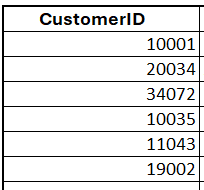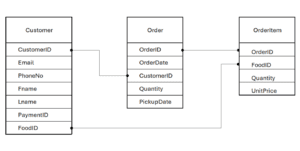A relational database is a system for organizing, managing, and analyzing data. To grasp the concept and the components of this relational database, let’s use a restaurant example to discuss each component in detail:
- Tables: A table is a structured set of data organized in rows and columns. Its purpose is to store and manage data efficiently. In our restaurant example, you might have tables for “Customer,” “Order,” “OrderItem,” and “Employee.” Each table would contain relevant data, such as customer names, order details, menu item descriptions, and employee information.
- Columns (Attributes): Columns, also known as attributes, define the structure of a table by specifying the type of data each entry in the table will hold. In the “Customers” table, for example, you might have columns like “CustomerID,” “FName,” “LName,” “Email,” and “PhoneNo.” Each column represents a specific attribute of the customers, allowing you to store and organize customer information systematically.

- Rows (Records): Rows, or records, are individual instances of data stored within a table. Each row represents a single entry in the table. In our “Customer” table example, a row could represent a specific customer, containing their unique CustomerID, first name, last name, email, and phone number. By combining rows and columns, tables store data in a structured and easily accessible format.

- Primary Key: A primary key is a unique identifier for each row in a table. It ensures that no two rows have the same identifier, providing a consistent way to reference specific records. In the “Customer” table, the “CustomerID” column might serve as the primary key. This would mean that each customer has a unique CustomerID that distinguishes them from other customers in the table.
 Foreign Key: A foreign key is a column or set of columns in a table that refers to the primary key of another table. It is used to establish relationships between tables, allowing you to associate data across multiple tables in a meaningful way. For example, in the “Order” table, you might have a “CustomerID” column as a foreign key. This would allow you to link orders to specific customers in the “Customer” table, providing insights into customer preferences and ordering habits.
Foreign Key: A foreign key is a column or set of columns in a table that refers to the primary key of another table. It is used to establish relationships between tables, allowing you to associate data across multiple tables in a meaningful way. For example, in the “Order” table, you might have a “CustomerID” column as a foreign key. This would allow you to link orders to specific customers in the “Customer” table, providing insights into customer preferences and ordering habits.